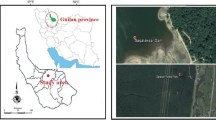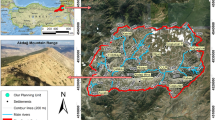Abstract
Forest soil conditions can be affected by ground-based harvesting; the degree of impact depends upon management factors, location of stands, soil, and topographical conditions. The present study predicted the area and extent of the disturbance of forest soil using soil data collected from 39 ground-based working areas. Random sampling was used to lay out 351 circular sample plots, each with a radius 10 m and located within 39 working areas, before the beginning of logging operations. Data regarding local conditions including stand characteristics, terrains, physical and mechanical properties of the soil, and extraction method was collected and used as predictor variables. Soil compaction, displacement, and rutting were defined as the response variables and were measured post-harvest. The results showed that E-value, cone index, and extracted volume had the most effect on the area of compaction. The lowest soil displacement was recorded at gentle slope and extracted volume of less than 5 m3/ha in clay–loam soil. Rutting of clay soil was most effectively predicted using E-value, slope, and extracted volume. A geospatial-explicit predictive model of soil disturbance was developed using a generalized additive model by implementation of generalized regression analysis and spatial prediction. Land types susceptible to detrimental soil disturbance during ground-based harvest operations were depicted geospatially by GIS. The models can be used as a decision support tool to predict forest harvesting impacts on soil properties.










Similar content being viewed by others
References
Agherkakli B, Najafi A, Sadeghi SH (2010) Ground based operation effects on soil disturbance by steel tracked skidder in a steep slope of forest. J For Sci 56(6):278–284
Agherkakli B, Najafi A, Sadeghi SH, Zenner E (2014) Mitigating effects of slash on soil disturbance in ground-based skidding operations. Scand J For Res 29(4):1–7
Ampoorter E, Goris R, Cornelis WM, Verheyen K (2007) Impact of mechanized logging on compaction status of sandy forest soils. For Ecol Manag 241(1–3):162–174
Ampoorter E, Schrijver A, Van Nevel L, Hermy M, Verheyen K (2012) Impact of mechanized harvesting on compaction of sandy and clayey forest soils: results of a meta-analysis. Ann For Sci 69:533–542
ASTM D 6528-07 (2007) Standard test method for consolidated undrained direct simple shear testing of cohesive soils. American Society for Testing and Materials, USA.
Botta GF, Vazquez JM, Tolon Becerra A, Balbuena R, Stadler S (2012) Soil compaction distribution under land clearing in calden (Prosopis Caldenia Burkart) forest in Argentinean pampas. Soil Tillage Res 119:70–75
Campbell DMH, White B, Arp PA (2013) Modeling and mapping soil resistance to penetration and rutting using LiDAR-derived digital elevation data. J Soil Water Conserv 68(6):460–473
Carter EA, Aust WM, Burger JA (2007) Soil strength response of select soil disturbance classes on a wet pine flat in South Carolina. For Ecol Manag 247:131–139
Cohen JA (1960) Coefficient of agreement for nominal scales. Educ Psychol Meas 20:37–46
Curran MP, Miller RE, Howes SW, Maynard DG, Terry TA, Heninger RL, Niemann T, van Rees K, Powers RF, Schoenholtz SH (2005) Progress towards more uniform assessment and reporting of soil disturbance for operations, research, and sustainability protocols. For Ecol Manag 220:17–30
Edlund J, Bergsten U, Arvidsson H (2013) A forest machine bogie with a bearing capacity dependent contact area: acceleration and angular orientation when passing obstacles and drawbar pull force and free rolling resistance on firm ground. Silva Fennica 47(3):7
Ezzati S, Najafi A, Durston T (2011) Impact of animal logging on soil physical properties in mule trail in Hyrcanian forests. Transp Res Part D Transp Environ 16(4):316–320
Fielding AH, Bell JF (1997) A review of methods for the assessment of prediction errors in conservation presence/absence models. Environ Conserv 24:38–49
Geissen V, Kim RY, Schöning A, St Schütte, Brümmer GW (2003) Effects of strip wise tillage in combination with liming on chemical and physical properties of acidic spruce forest soils after clear cutting. For Ecol Manag 180:75–83
Goetz JN, Guthrie RH, Brenning A (2011) Integrating physical and empirical landslide susceptibility models using generalized additive models. Geomorphology 129:376–386
Guisan A, Edwards TCJ, Hastie T (2002) Generalized linear and generalized additive models in studies of species distributions: setting the scene. Ecol Model 157:89–100
Han SK, Han HS, Page-Dumroese DS, Johnson LR (2009) Soil compaction associated with cut-to-length and whole tree harvesting of a coniferous forest. Can J For Res 39(5):976–989
Iskandar H, Snook LK, Toma T, MacDicken KG, Kanninen M (2006) A comparison of damage due to logging under different forms of resource access in East Kalimantan, Indonesia. For Ecol Manag 237:83–93
Kosir B (2008) Damage to young forest due to harvesting in shelterwood systems. Croat J For Eng 29(2):141–153
Landis JR, Koch GG (1977) The measurement of observer agreement for categorical data. Biometrics 33:159–174
Lehmann A, Overton JM, Leathwick JR (2002) GRASP: generalized regression analysis and spatial prediction. Ecol Model 157:189–207
Marchi E, Picchio R, Spinelli R, Verani S, Venanzi R, Certini G (2014) Environmental impact assessment of different logging methods in pine forests thinning. Ecol Eng 70:429–436
Marko G, Pismuz P, Peterfalvi J (2013) Measuring the bearing capacity of forest roads with an improved Benkelman beam apparatus. Acta Silv Lingaria Hung 9:97–109
McDonald TP, Seixas F (1997) Effect of slash on forwarder soil compaction. Int J For Eng 8:15–26
McKenzie N, Coughlan K, Cresswell H (2002) Soil physical measurement and interpretation for land evaluation. CSIRO Publishing, Collingwood, p 379
Miller RE, Colbert SR, Morris LA (2004) Effects of heavy equipment on physical properties of soils and on long-term productivity: a review of literature and current research. NCASI Technical Bulletin 887. National Council for Air and Stream Improvement (NCASI Publishing), USA
Miller RE, McIver JD, Howes SW, Gaueman WB (2010) Assessment of soil disturbance in forests of the interior Columbia River basin: a critique. USDA Forest Service. General Technical Report. Published in cooperation with: USA. Department of the interior bureau of land management, Portland Oregon, PNW-GTR-811
Najafi A, Solgi A (2010) Assessing site disturbance using two ground survey methods in a mountain forest. Croat J For Eng 31:47–55
Najafi A, Solgi A, Sadeghi SH (2009) Soil disturbance following four wheel rubber skidder logging on the steep trail in the north mountainous forest of Iran. Soil Tillage Res 103:165–169
Owende PMO, Lyons J, Haarlaa R, Peltola A, Spinelli R, Molano J, Ward SM (2002) Operations protocol for eco-efficient wood harvesting on sensitive sites. Ireland. http://www.ucd.ie/foresteng/html/ecowood/op.pdf. December 2002
Picchio R, Neri F, Petrini E, Verani S, Marchi E, Certini G (2012) Machinery-induced soil compaction in thinning two pine stands in central Italy. For Ecol Manag 285:38–43
Pinard MA, Barker MG, Tay J (2000) Soil disturbance and post-logging forest recovery on bulldozer paths in Sabah, Malaysia. For Ecol Manag 130:213–225
Rab MA (1992) Impact of timber harvesting on soil disturbance and compaction with reference to residual log harvesting in East Gippsland, Victoria-a review. VSP Tech. Rep. No. 13. Native Forest Research, Department of Conservation and Environment, Victoria, Australia
Reeves DA, Reeves MC, Abbott AM, Page-Dumroese DS, Coleman MD (2012) A detrimental soil disturbance prediction model for ground-based timber harvesting. Can J For Res 42:821–830
Solgi A, Najafi A, Sadeghi SHR (2009) Soil disturbance following four wheel rubber skidder logging on the steep trail in the north mountainous forest of Iran. Soil Tillage Res 103:165–169
Sowa J, Kulak D (2008) Probability of occurrence of soil disturbance during timber harvesting. Croat J For Eng 29(1):29–39
Tessier S, Lachance B, Laguë C, Chen Y, Chi L, Bachand D (1997) Soil compaction reduction with a modified one-way disker. Soil Tillage Res 42:63–77
Van Den Eeckhaut M, Vanwalleghem T, Poesen J, Govers G, Verstraeten G, Vandekerckhove L (2006) Prediction of landslide susceptibility using rare events logistic regression: a case-study in the Flemish Ardennes (Belgium). Geomorphology 76:392–410
Vanags C, Minasny B, McBratney AB (2004) The dynamic penetrometer for assessment of soil mechanical resistance. SuperSoil 2004, 3rd Australian-New Zealand Soils Conference. 5-9 December. University of Sydney, Sidney, Australia. Published by The Regional Institute Ltd, Published on CDROM. https://www.regional.org.au/au/asssi/supersoil2004/s14/poster/1565_vanagsc.htm
Vorpahl P, Elsenbeer H, Mrker M, Schrder S (2012) How can statistical models help to determine driving factors of landslides? Ecol Model 239:27–39
Williamson JR, Neilsen WA (2000) The influence of forest site on rate and extent of soil compaction and profile disturbance of skid trails during ground-based harvesting. Can J For Res 30:1196–1205
Yeclinacar EK (2005) The application of computational intelligence to landslide susceptibility mapping in Turkey. PhD Thesis, Department of Geomatics the University of Melbourne, Melbourne, Australia
Zhang L, Gove JH, Heath LS (2005) Spatial residual analysis of six modeling techniques. Ecol Model 186:154–177
Author information
Authors and Affiliations
Corresponding author
Additional information
Communicated by Eric R. Labelle.
Publisher's Note
Springer Nature remains neutral with regard to jurisdictional claims in published maps and institutional affiliations.
Rights and permissions
About this article
Cite this article
Shabani, S., Najafi, A., Majnonian, B. et al. Spatial prediction of soil disturbance caused by forest logging using generalized additive models and GIS. Eur J Forest Res 138, 595–606 (2019). https://doi.org/10.1007/s10342-019-01180-8
Received:
Revised:
Accepted:
Published:
Issue Date:
DOI: https://doi.org/10.1007/s10342-019-01180-8




